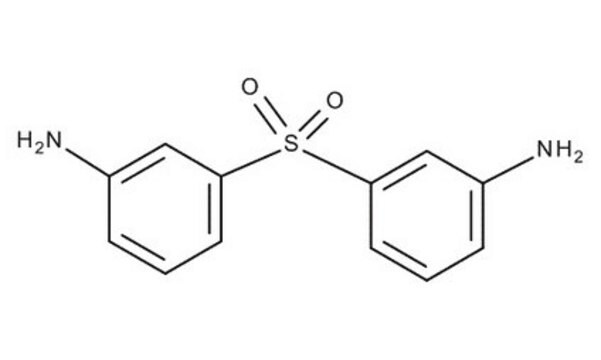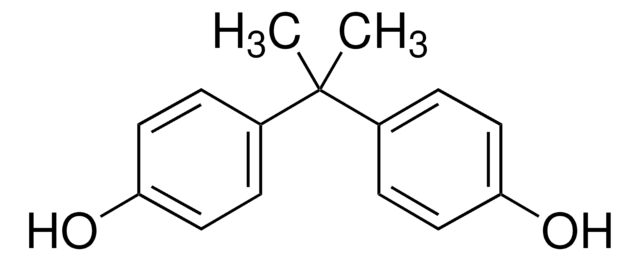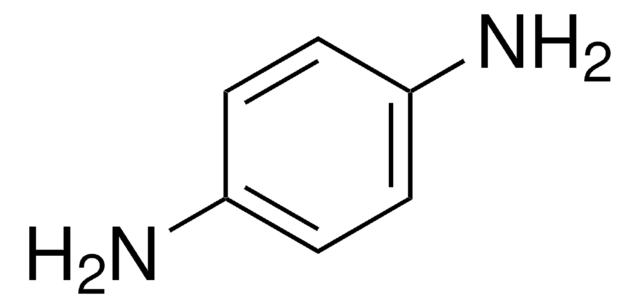8.22289
1-Naphthol
for synthesis
Synonim(y):
1-Naphthol, 1-Hydroxynaphthalene
About This Item
Polecane produkty
ciśnienie pary
1.3 hPa ( 94 °C)
Poziom jakości
Próba
≥99% (GC)
Postać
solid
temp. samozapłonu
510 °C
siła działania
1870 mg/kg LD50, oral (Rat)
880 mg/kg LD50, skin (Rabbit)
metody
UV/Vis spectroscopy: suitable
tw
288 °C/1013 hPa
mp
94-96 °C
temp. przejścia
flash point 125 °C
rozpuszczalność
0.1 g/L
gęstość
1.28 g/cm3 at 20 °C
gęstość nasypowa
450 kg/m3
temp. przechowywania
2-30°C
InChI
1S/C10H8O/c11-10-7-3-5-8-4-1-2-6-9(8)10/h1-7,11H
Klucz InChI
KJCVRFUGPWSIIH-UHFFFAOYSA-N
Szukasz podobnych produktów? Odwiedź Przewodnik dotyczący porównywania produktów
Zastosowanie
<li><strong>Real-time deflection and friction force imaging by bimorph-based resonance-type high-speed scanning force microscopy in the contact mode.</strong>: This study employs fluorine-doped tin oxide coated glass slides in a novel microscopy technique that enhances real-time imaging capabilities, demonstrating its applicability in high-speed, high-resolution surface analysis (Cai et al., 2014).</li>
<li><strong>Langmuir-Blodgett films of self-assembled (alkylether-derivatized Zn phthalocyanine)-(C imidazole adduct) dyad with controlled intermolecular distance for photoelectrochemical studies.</strong>: This research explores the use of fluorine-doped tin oxide as a substrate for Langmuir-Blodgett films, focusing on their potential in creating highly organized molecular assemblies for enhanced photoelectrochemical applications (Obraztsov et al., 2014).</li>
<li><strong>Formation of an electron hole doped film in the α-Fe2O3 photoanode upon electrochemical oxidation.</strong>: The paper describes the advantageous characteristics of fluorine-doped tin oxide in forming electron hole doped films on α-Fe2O3 photoanodes, pivotal for improving the efficiency of photoelectrochemical cells (Gajda-Schrantz et al., 2013).</li>
<li><strong>BiSI Micro-Rod Thin Films: Efficient Solar Absorber Electrodes</strong>: Investigates the role of fluorine-doped tin oxide coated glass slides in enhancing the photoelectrochemical properties of BiSI micro-rod thin films, suggesting potential applications in solar energy conversion and storage systems (Hahn et al., 2012).</li>
</ul>
Komentarz do analizy
Melting range (lower value): ≥ 94 °C
Melting range (upper value): ≤ 96 °C
Identity (IR): passes test
Hasło ostrzegawcze
Danger
Zwroty wskazujące rodzaj zagrożenia
Zwroty wskazujące środki ostrożności
Klasyfikacja zagrożeń
Acute Tox. 3 Dermal - Acute Tox. 4 Oral - Aquatic Acute 1 - Aquatic Chronic 3 - Eye Dam. 1 - Skin Irrit. 2 - Skin Sens. 1A - STOT SE 2 Oral - STOT SE 3
Organy docelowe
Kidney, Respiratory system
Kod klasy składowania
6.1C - Combustible acute toxic Cat.3 / toxic compounds or compounds which causing chronic effects
Klasa zagrożenia wodnego (WGK)
WGK 1
Temperatura zapłonu (°F)
257.0 °F - closed cup
Temperatura zapłonu (°C)
125 °C - closed cup
Certyfikaty analizy (CoA)
Poszukaj Certyfikaty analizy (CoA), wpisując numer partii/serii produktów. Numery serii i partii można znaleźć na etykiecie produktu po słowach „seria” lub „partia”.
Masz już ten produkt?
Dokumenty związane z niedawno zakupionymi produktami zostały zamieszczone w Bibliotece dokumentów.
Klienci oglądali również te produkty
Nasz zespół naukowców ma doświadczenie we wszystkich obszarach badań, w tym w naukach przyrodniczych, materiałoznawstwie, syntezie chemicznej, chromatografii, analityce i wielu innych dziedzinach.
Skontaktuj się z zespołem ds. pomocy technicznej










